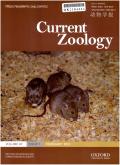乌拉圭大闸蟹的蟹爪颜色与雄性质量无关
IF 2
2区 生物学
Q2 ZOOLOGY
引用次数: 0
摘要
由于信号源的生理状态与显示的颜色之间存在关联,因此性选择被认为在颜色的进化过程中发挥了重要作用。因此,研究人员通常会研究颜色与信号源的质量(如体型或身体状况)之间的关系。然而,有关颜色与个体质量之间关系的研究往往受到分类学的限制,研究人员通常会研究颜色表型与质量指标(如体型的线性度量)之间的关系。在这里,我们研究了雄性大闸蟹(Leptuca uruguayensis)的体型、爪子大小、爪子肌肉质量、脂质含量和爪子颜色之间的关系。我们假设,如果颜色与雄性品质的一个或多个指数相关,那么雄性乌拉圭大闸蟹爪子上显示的颜色可能会受到性选择的影响。我们发现,在我们拍摄的个体中,Leptuca uruguayensis爪子的颜色差异很大。但是,我们没有发现爪色与质量指标之间的相关性;亮度和色调都与我们测量的质量指标无关。我们的研究结果表明,乌拉圭蛙的爪色不太可能是进化而来的质量信号,而可能是作为物种识别或非指示性的性信号。本文章由计算机程序翻译,如有差异,请以英文原文为准。
Claw coloration in the fiddler crab Leptuca uruguayensis has no correlation with male quality
Sexual selection is thought to play a major role in the evolution of color due to the correlation between a signaler’s physiological state and the displayed color. As such, researchers often investigate how color correlates to the quality of the signaler, like size or body condition. However, research on the relationship between color and individual quality is often taxonomically limited and researchers typically investigate how color phenotypes relate to one index of quality, such as a linear measure of body size. Here, we investigated the relationship between body size, claw size, claw muscle mass, lipid content, and the color of the claw in male fiddler crabs (Leptuca uruguayensis) which wield an exaggerated claw that varies in color from brown to red. We hypothesized that if color was correlated to one or more indices of male quality, the color displayed on the claws of male L. uruguayensis could be under sexual selection. We found Leptuca uruguayensis claw color varies substantially among the individuals we photographed. However, we did not find a correlation between claw color and indices of quality; neither brightness nor hue correlated to the indices of quality we measured. Our findings suggest that claw color in L. uruguayensis is unlikely to have evolved to signal quality, but may instead function as a species identity or as a non-indicator sexual signal.
求助全文
通过发布文献求助,成功后即可免费获取论文全文。
去求助
来源期刊

Current Zoology
Agricultural and Biological Sciences-Animal Science and Zoology
CiteScore
3.20
自引率
9.10%
发文量
111
审稿时长
6 weeks
期刊介绍:
About the Journal
Current Zoology (formerly Acta Zoologica Sinica, founded in 1935) is an open access, bimonthly, peer-reviewed international journal of zoology. It publishes review articles and research papers in the fields of ecology, evolution and behaviour.
Current Zoology is sponsored by Institute of Zoology, Chinese Academy of Sciences, along with the China Zoological Society.
 求助内容:
求助内容: 应助结果提醒方式:
应助结果提醒方式:


